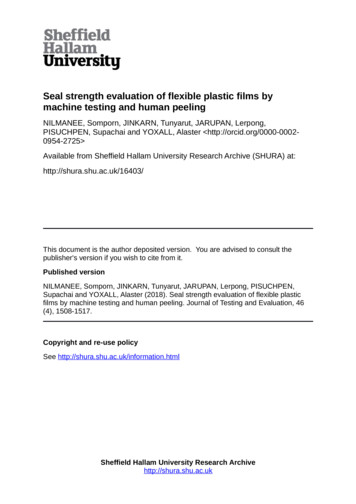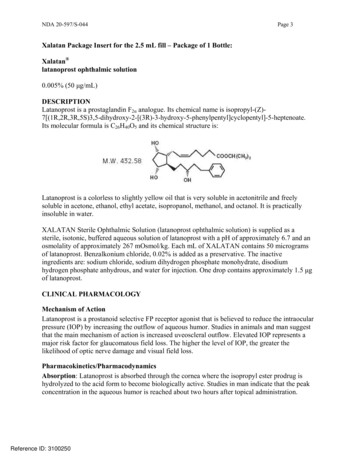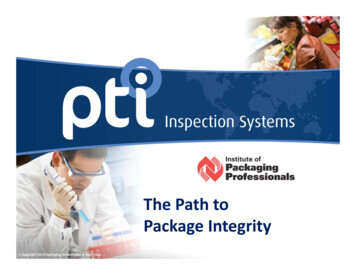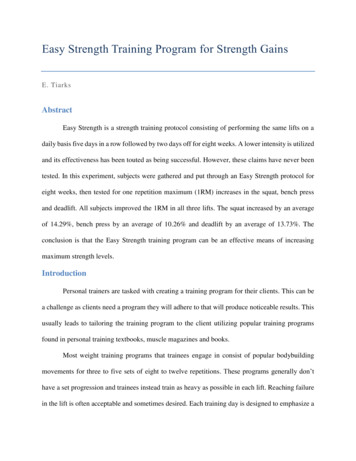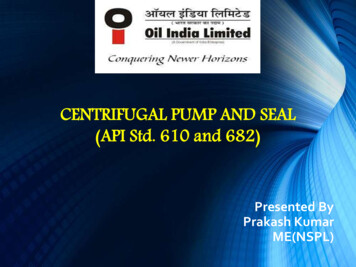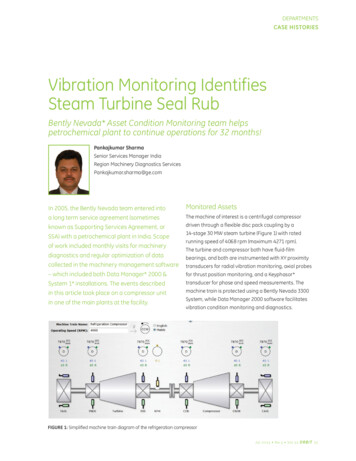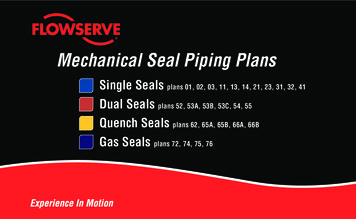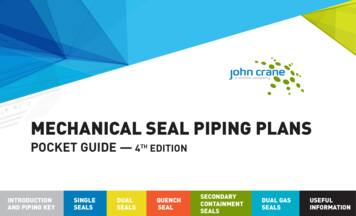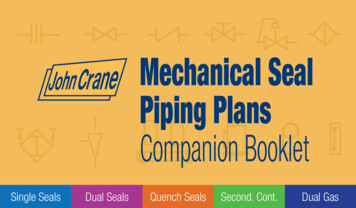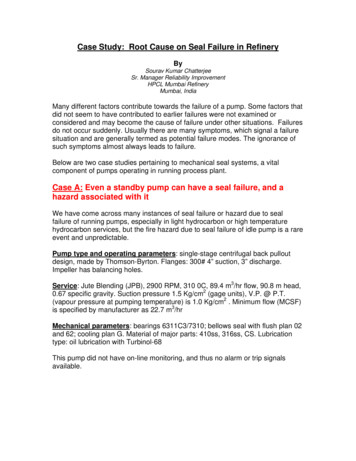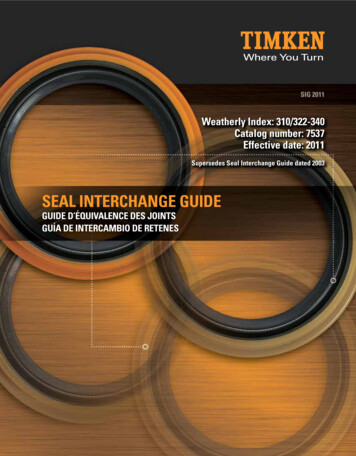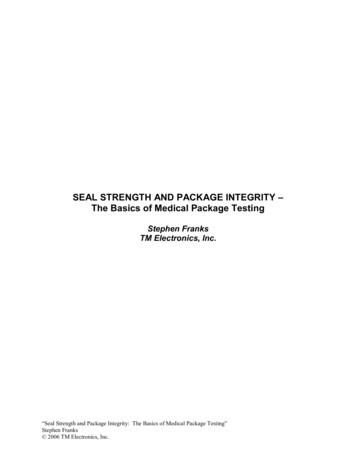
Transcription
SEAL STRENGTH AND PACKAGE INTEGRITY –The Basics of Medical Package TestingStephen FranksTM Electronics, Inc.“Seal Strength and Package Integrity: The Basics of Medical Package Testing”Stephen Franks 2006 TM Electronics, Inc.
Part 1: Seal Strength TestingThe objective of package testing for medical packages is twofold: first, to ensure the integrity ofthe sealed package, and second, to assure that no weaknesses in the sealed areas of thepackage permit leaks to develop during sterilization, normal handling, transportation andstorage. Testing of a medical package must yield a comprehensive view of its ability to provideand maintain a sterile barrier around the medical device or product. According toANSI/AAMI/ISO11607-1997 Packaging for terminally sterilized medical devices, both sealstrength testing and package integrity testing are needed in order to properly validate yourdesign and document your conformance to specifications. In this article we will look closely atseal strength testing.Seal strength testing evaluates the mechanical strength of the seal, assuring proper bonding tomaintain package integrity throughout the life of the package. Package integrity implies themaintenance of the sterile barrier property of the package. It is important to understand thatseal strength and package integrity are distinctly separate objectives of the package testingprocess.Seal strength is a package attribute; data acquired can be used to validate the package designas adequate for maintenance of integrity, to monitor process performance, and to confirm shelflife performance. The seal strength also provides assurance of control of the “peelable”characteristic of the package. There are two basic types of seal strength testing addressed inISO-11607: tensile strength testing and burst or creep(inflation) testing.Tensile seal strength testing (ASTM F88) uses a definedwidth sample (25.4mm) of the package seal perimeter. Ajaw moving at a defined constant rate 10 to 12 in/min. pullsthe seal apart while measuring the resistance force duringseal separation. A typical seal strength plot is shown inFigure 1.This test is particularly applicable to peelable medicalpackage seals. It has the advantage of determining the force Figure 1: Typical tensile strength test plotrequired by the end user to open a peelable package as wellas providing force data that can be used in validation and control of the sealing process.Interpretation of the tensile seal strength result and plot is an important factor in reportingresults. The resultant plot may show a higher peak force on the initiation of the test followed bya relatively constant force region during the peel apart of the seal and may be concluded withanother higher peak. It is vital to the test result interpretation that the test report include theregion of measurement; that is, peak initial force, sustaining region force or average energy(area under the curve). More help in interpreting the results can be found in ASTM F-88.Another important reporting factor is the configuration of the sample support. Samples may berun with a free or supported seal, called a tail (see Figure 2). Both methods are acceptable butit is important to note that the stress/ strain curves or results are NOT equivalent. In the “freetail” method, the angle of peel is constantly varying from 90 degrees to greater than 90 degrees.In the “supported tail”, the tail is restrained by the use of a fixture to keep the angle of peel at“Seal Strength and Package Integrity – The Basics of Medical Package Testing”Stephen Franks 2006 TM Electronics, Inc.2
180 degrees. The force result will vary depending on the supportcondition. Test results cannot be compared for different supportconditions.Free TailSupported TailThe tensile seal strength test is a valuable testing tool for sealevaluation. Its limitations are that only single sections of a seal Figure 2: “Free” vs. “Supported” Tail Tensileare evaluated at one time, thus not providing information on Test Designwhole package integrity and the process of testing is relativelyslow for process control considerations. Its strengths are specific force results for peelablepackages and wide usage within the industry.Inflation Seal Strength Testing (ASTM F1140 and F2054), including burst, creep and creep-tofailure testing, requires pressurizing the entire package and measuring the peak rupturepressure (burst test) or the time to failure at a constantly held pressure (creep and creep-tofailure test). These tests provide a whole-package minimum seal strength and are equallyapplicable to peelable and non-peelable seals. Inflation tests are applicable to most packageforms such as pouches, header bags, lidded trays, flexible or rigid blisters and laminated orrolled tubes.Although no universal mathematical relationship has been defined between inflation and tensileseal strength tests, research has been done on pouch forms that establishes a good correlationbetween restrained plate inflation testing – discussed later in this article – and tensile testing inlocating the minimum seal strength area. (Franks, Stephen H. and Donald S. Barcan.“Examining the Relationship of Tensile and Inflation Seal Strength Tests in Medical Pouches”. 1999, Donbar Industries, Inc. & TM Electronics, Inc.).Burst TestWhole package inflation tests are categorized as burst tests,creep tests or creep-to-failure tests (ASTM F1140 or F2054).To perform a burst test, a package is inflated at a uniform rateuntil the seal separates at the point of greatest weakness. Theburst test is a peak inflation pressure test. It is a variable test;the variable is the back pressure inside the package at theinstant of seal rupture. Figure 3 is a graphic plot of a burst testprovided by the TM Electronics BT-1000 Package Tester,Figure 3: Burst Testshowing the characteristic burst curve. In this illustration, theGraphtested part burst at a pressure of 176.0 In H2O. The burst pressure result is a variable statisticthat can be utilized to document process development and process control through the use oftools such as upper and lower control limits.In the burst test, air is introduced into the package at a predetermined pressure and flow rate(see Figure 4). Control of inflation rate is important in a burst test to ensure consistentconditions for the test method, similar to the tensile test method. The porosity (or lack thereof)of the package material determines the inflation rate for the burst test. Because air escapesthrough the walls of a porous package during inflation, the flow rate must be increased tocompensate for the lost air through the walls and create the back pressure in the porouspackage. This pressure creates the force to rupture the seal.“Seal Strength and Package Integrity – The Basics of Medical Package Testing”Stephen Franks 2006 TM Electronics, Inc.3
Limitations of the burst test are thatpackage characteristics will varyPorous Pouchthe resultant value. For example,the character of the seal itself is aAirRegulatorInputfactor; peelable seals will partunder a lower pressure than thenon-peelable seals found in formedpackages. The size of the packagewill influence the resultant value;burst values of a large package willFigure 4 – where does inflation pressure come from?be lower than that of a smallerpackage. Unrestrained packagesmay have material failures before the seal fails. These issues are not a factor when testing asingle style package with consistent methodology and are offset by the speed of the test, whichprovides access to process data in seconds. The burst test does not require samplepreparation and can be run with minimum operator training.Flow ValveWhole Package Creep TestsCreep Test201816Pressure141210Pressure864200510Time (sec)1520The Creep Test is a second general type of wholepackage inflation seal strength test. In the Creep Test, awhole package is inflated to a constant pressure, whichis then held for a specified time, resulting in a pass/failresult (see Figure 5). Early users of the method forpeelable seals used the test as an analogy for thepressure difference on the seals seen in the ETOsterilization and air transport cycles. The Creep testprovides a test for slow shear of the adhesive bondsimilar to a dead weight hanging on the seal. It isimportant to first determine the burst strength of thepackage; a suggested starting pressure for peelableseals in ASTM F1140 is to begin evaluating your seal with a creep pressure that is about 80% ofthe burst value. Different seal adhesive systems may require a lower creep test pressure to beeffective, for example, pressure sensitive adhesives. Inflation rate of the test is not critical aslong as the initial fill is not so fast to shock the seal or too slow to cause an effectively longertest time.Figure 5: Typical Creep Test PlotShortcomings of the Creep Test include the need for the operator to visually examine the seal atthe end of the test to declare the amount of seal peel for process control and the lack of avariable statistic upon which to perform process control analysis.The Creep-to-failure Test (CTF) is a variation on the Creep Test that addresses theseweaknesses. In the Creep-to-failure Test, the test pressure on the inflated package is held untilthe seal actually fails, yielding an end point value (a variable statistic), time to failure, andpinpointing the area of greatest weakness in the seal (ASTM F1140 method b2). Time to failurecan then be used in SPC or SQC methods.To achieve sensitive, repeatable results using both burst and creep inflation tests, testequipment must be used that takes into consideration the configuration of the package.“Seal Strength and Package Integrity – The Basics of Medical Package Testing”Stephen Franks 2006 TM Electronics, Inc.4
Completely sealed packages need an access probe to inflatethe package. This probe may require reinforcement to preventmaterial splitting at the entry point. Open pouches (sealed ononly three sides) are sealed with a mechanical clamp topressurize the three formed pouch seals. Figure 6 illustratesone method of closing an open package for seal strengthtesting as well as a device designed to provide reinforced anda leak-tight air path into a completely sealed package.Figure 6: Open package testfixture (above); “Package Port”leak-tight entry (right)Inflation seal strength testing on unrestrained packages, ASTM F1140, provides a fast andeffective method of evaluating package seal strength. A shortcoming of this method is that thereare no specific standards for a package’s inflation seal strength, since the seal strength valuesare relative to the packagesize, geometry, materials and bonding agents, although tests haveproven over time to provide consistent process data on a package that is tested underconsistent, repeatable conditions. In addition, shortcomings of the unrestrained method arerecognized for geometry effects of the package on the interpretation of test results. Forexample, pouches with a long side seal will generally fail on the long seal unless a heater failurehas occurred on the shorter seal or chevron. Unsupported tray lid seals may fail at points onlyrelative to their geometry. Very flexible package materials may deform with pressurization to anextent that makes seal testing difficult. To address these problems, it may be advisable to userestraining plates for your inflation testing.Restrained Package Testing (ASTM 2054)So far we have discussed seal strength testing of packages unrestrained in any axis (ASTMF1140). Restrained package testing is a refinement that has several advantages: it has beenshown in pouches to define the minimum seal strengthFarea more consistently, provides more consistentloading on the package seal, and incidentallyHoop StressFcorrelates well with tensile seal strength tests indefining the minimum seal strength area.Internal PressureThe geometry of the package under test affects thedistribution of internal pressure forces on the packagesurface and seals. A pouch-form package unrestrainedin any axis exhibits circumferential hoop stress when Figure 7a: Circumferential Hoop Stressinternal pressure is applied (Figure 7a). When thepackage is restrained, the load application isdistributed directly on the seal area, and,because material stretching and deformationis minimized, the test forces are moreuniformly applied (Figures 7b and 7c).Figure 7b: Restrained plate test forces (bags)“Seal Strength and Package Integrity – The Basics of Medical Package Testing”Stephen Franks 2006 TM Electronics, Inc.5
Inflation ProbeRestraining PlateFixture1/8”Closed TrayFigure 7c: Restrained plate test forces (trays)consistent. One must not compare results of differentpackages or different test conditions on the package,such as restraining plate gap, when analyzing data.Establish a set of test conditions for each package andreproduce those conditions consistently.Rexam PLK-201 Film/ Film12.10.Pressure (psi)In addition, package restraint has a directrelationship to burst pressures: the wider the gapbetween restraining plates, the lower the averageburst pressure, with unrestrained packages yieldingthe lowest burst pressure of all (figure 7d). The mostimportant factor in the interpretation of results is thatall conditions in the package test method are8.06.0PbPbPb-4.0Figure 8 illustrates a restrained package fixture. Use of2.0package restraints must be approached with caution;0.0because of pressures exerted on the plates, extreme0.20.50.71.0UGap (in)care must be taken that fixtures are designed towithstand the forces applied by the inflated package Figure 7d: Plot of Burst Pressure vs. Gap(Franks, Stephen. “Calculating Factors of Safety forPackage Burst and Creep Test Fixtures”. Medical Device & Diagnostic Industry, June, 1998).Inflation seal strength test results provide an excellent tool for process control. Inflation Bursttest results, creep-to-failure and tensile data are allamenable for use in cont
Tensile seal strength testing (ASTM F88) uses a defined width sample (25.4mm) of the package seal perimeter. A jaw moving at a defined constant rate 10 to 12 in/min. pulls the seal apart while measuring the resistance force during seal separation. A typical seal strength plot is shown in Figure 1. This test is particularly applicable to peelable medical package seals. It has the advantage of .
